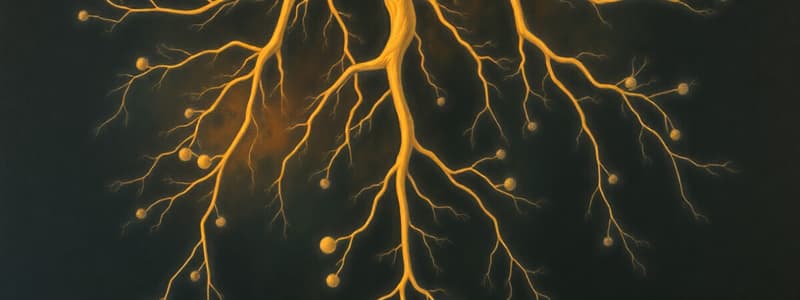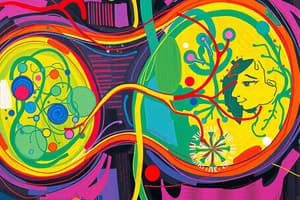Podcast
Questions and Answers
What is the primary role of the tonsils?
What is the primary role of the tonsils?
- Produce T-cells
- Trap pathogens entering the oral cavity (correct)
- Filter lymph fluid
- Store red blood cells
Which component of the lymphatic system is primarily responsible for the development of T-cells?
Which component of the lymphatic system is primarily responsible for the development of T-cells?
- Lymph nodes
- Spleen
- Bone marrow
- Thymus (correct)
What is the main function of the white pulp in the spleen?
What is the main function of the white pulp in the spleen?
- Transport lymph fluid
- Generate antibodies and filter antibody-coated bacteria (correct)
- Store platelets
- Destroy old blood cells
Where are lymph nodes primarily located?
Where are lymph nodes primarily located?
What role do dendritic cells play in the lymphatic system?
What role do dendritic cells play in the lymphatic system?
What are Peyer's patches associated with?
What are Peyer's patches associated with?
Which part of the spleen is responsible for filtering blood and destroying old blood cells?
Which part of the spleen is responsible for filtering blood and destroying old blood cells?
What is a key feature of the lymphatic vessels?
What is a key feature of the lymphatic vessels?
What do lymph nodes contain that contributes to their immune response?
What do lymph nodes contain that contributes to their immune response?
What does the spleen store for emergencies?
What does the spleen store for emergencies?
What is the main reason the lymphatic system does not require a pump?
What is the main reason the lymphatic system does not require a pump?
Which of the following is NOT a lymphatic trunk?
Which of the following is NOT a lymphatic trunk?
What role do lacteals serve in the lymphatic system?
What role do lacteals serve in the lymphatic system?
What is the primary function of the lymphatic system?
What is the primary function of the lymphatic system?
What happens when the smooth muscle in lymph vessels contracts?
What happens when the smooth muscle in lymph vessels contracts?
How much interstitial fluid is typically not reabsorbed back into the capillaries each day?
How much interstitial fluid is typically not reabsorbed back into the capillaries each day?
Which duct is located at the junction of the right jugular vein and right subclavian vein?
Which duct is located at the junction of the right jugular vein and right subclavian vein?
What structure allows lymphatic capillaries to stay flexible and maintain their shape?
What structure allows lymphatic capillaries to stay flexible and maintain their shape?
How do lymphoid organs contribute to the immune system?
How do lymphoid organs contribute to the immune system?
What type of tissue is described as a loose arrangement of lymphoid cells and proteins?
What type of tissue is described as a loose arrangement of lymphoid cells and proteins?
What happens to the mini-valves of lymphatic capillaries when pressure in the interstitial space is greater than inside the capillary?
What happens to the mini-valves of lymphatic capillaries when pressure in the interstitial space is greater than inside the capillary?
Which types of molecules does the lymphatic system help to transport into the blood?
Which types of molecules does the lymphatic system help to transport into the blood?
What does the lymphatic system aid in delivering during a meal?
What does the lymphatic system aid in delivering during a meal?
What is the approximate daily volume of fluid that seeps out of capillaries into the interstitial space?
What is the approximate daily volume of fluid that seeps out of capillaries into the interstitial space?
Which of the following statements about the lymphatic system is true?
Which of the following statements about the lymphatic system is true?
What type of fluid does the lymphatic system collect and return to the circulation?
What type of fluid does the lymphatic system collect and return to the circulation?
What are chylomicrons responsible for transporting?
What are chylomicrons responsible for transporting?
Which of the following statements about the lymphatic system is true?
Which of the following statements about the lymphatic system is true?
What role do collagen filaments play in the lymphatic system?
What role do collagen filaments play in the lymphatic system?
What is the nature of fluid flow within the lymphatic system?
What is the nature of fluid flow within the lymphatic system?
Flashcards
Lymph
Lymph
Fluid that circulates within the lymphatic system.
Key roles of the lymphatic system
Key roles of the lymphatic system
Returns fluids, helps large molecules enter blood, aids in immune surveillance.
Interstitial fluid
Interstitial fluid
Fluid located between cells; includes water and proteins.
Lymphatic capillaries
Lymphatic capillaries
Signup and view all the flashcards
Mini-valves in lymphatic capillaries
Mini-valves in lymphatic capillaries
Signup and view all the flashcards
Fluid reabsorption
Fluid reabsorption
Signup and view all the flashcards
Volume of fluid seepage
Volume of fluid seepage
Signup and view all the flashcards
Lymphatic system and blood volume
Lymphatic system and blood volume
Signup and view all the flashcards
One-way valves function
One-way valves function
Signup and view all the flashcards
Fluid movement direction
Fluid movement direction
Signup and view all the flashcards
Lymphatic System Function
Lymphatic System Function
Signup and view all the flashcards
Lymph Vessel Contraction
Lymph Vessel Contraction
Signup and view all the flashcards
Lymphatic Trunks
Lymphatic Trunks
Signup and view all the flashcards
Right Lymphatic Duct
Right Lymphatic Duct
Signup and view all the flashcards
Thoracic Duct
Thoracic Duct
Signup and view all the flashcards
Lymph Movement Aid
Lymph Movement Aid
Signup and view all the flashcards
Chylomicrons
Chylomicrons
Signup and view all the flashcards
Lymphoid Organs
Lymphoid Organs
Signup and view all the flashcards
Diffused Lymphoid Tissue
Diffused Lymphoid Tissue
Signup and view all the flashcards
Role of Lymphatics
Role of Lymphatics
Signup and view all the flashcards
Lymph Nodes
Lymph Nodes
Signup and view all the flashcards
Tonsils
Tonsils
Signup and view all the flashcards
Lymphatic System Components
Lymphatic System Components
Signup and view all the flashcards
Thymus
Thymus
Signup and view all the flashcards
Spleen Functions
Spleen Functions
Signup and view all the flashcards
Red Pulp of Spleen
Red Pulp of Spleen
Signup and view all the flashcards
White Pulp of Spleen
White Pulp of Spleen
Signup and view all the flashcards
Pathogen Entry
Pathogen Entry
Signup and view all the flashcards
Dendritic Cells
Dendritic Cells
Signup and view all the flashcards
Peyer's Patches
Peyer's Patches
Signup and view all the flashcards
Study Notes
The Lymphatic System
- Lymph - fluid that flows through the lymphatic system
- Key roles of the lymphatic system
- It returns fluids from the tissues back to the heart
- It helps large molecules enter the blood (e.g. hormones and lipids)
- It helps with immune surveillance to aid in fighting infections
Daily approximate fluid volume
- Everyday approximately 20 liters of fluid (water and proteins) seeps out of capillaries - becoming part of the interstitial fluid between cells
- Approximately 3 liters are therefore left behind in the interstitial fluid
- The lymphatic system collects the remaining interstitial fluid and returns it to the blood, maintaining a consistent blood volume over time.
Lymphatic Capillaries
- The lymphatic system isn't a closed loop
- Fluid and proteins are absorbed into the lymphatic capillaries
- Lymphatic capillaries are the smallest lymphatic vessels
- They are located within the interstitial space
- Their walls are made of endothelial cells that loosely overlap - forming one way mini-valves
Studying That Suits You
Use AI to generate personalized quizzes and flashcards to suit your learning preferences.



